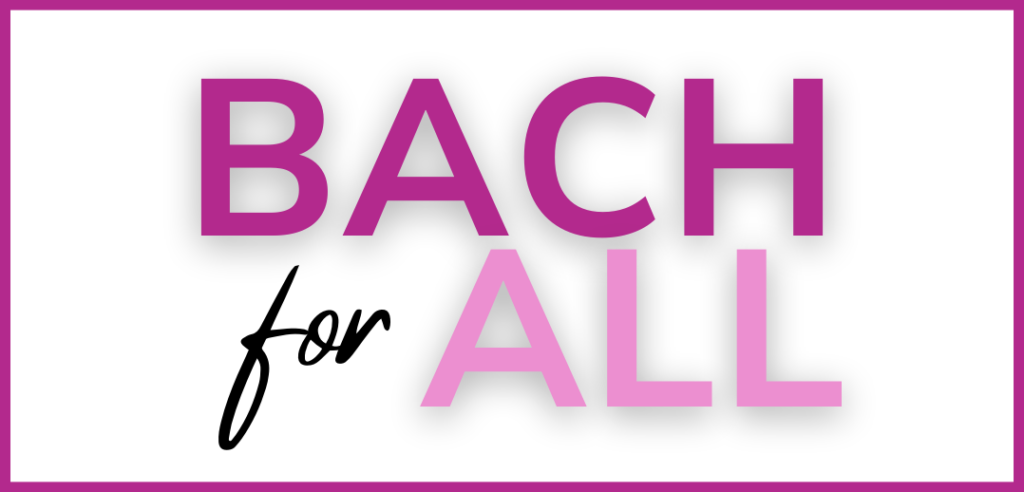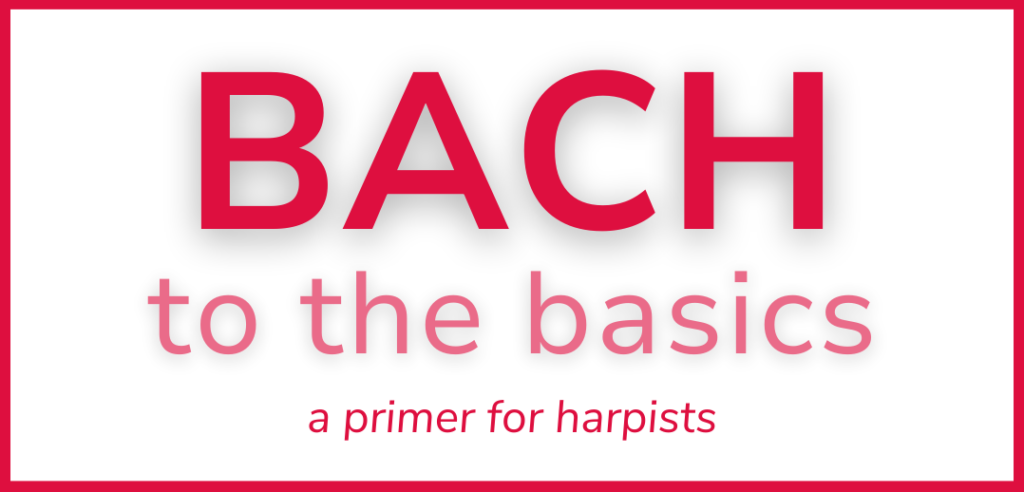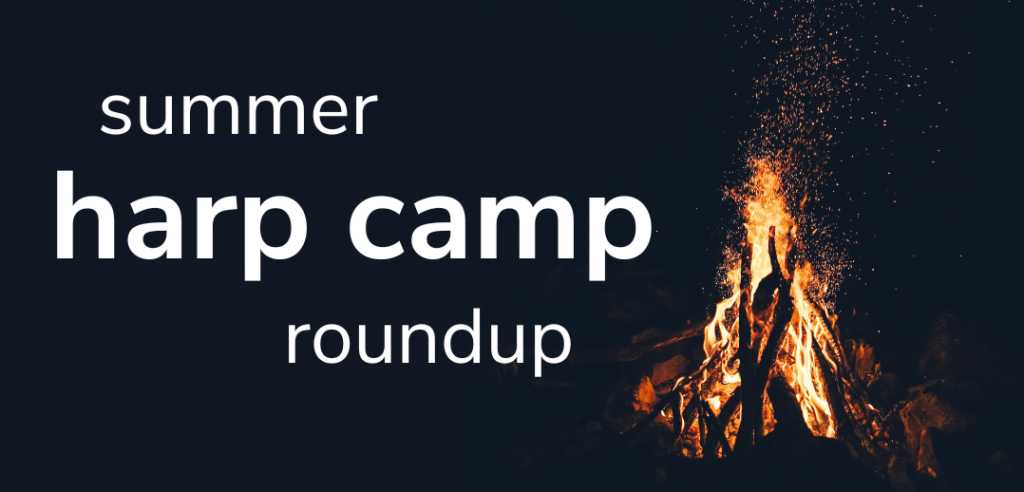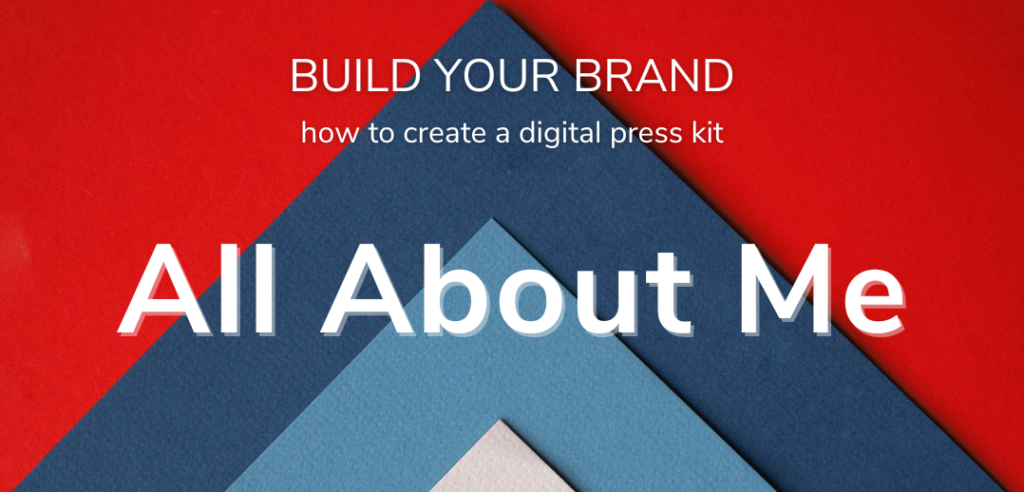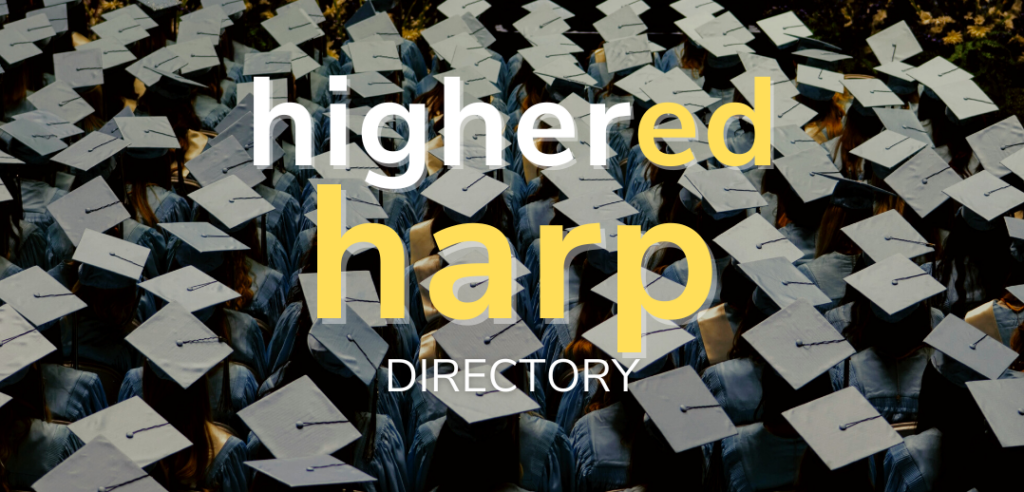
—by the Chicago Harp Quartet
In the harp world, getting to the gig is half the battle. Maybe even more than half the battle. Gigging is largely about schlepping—large instrument, larger car, stand, cart, amp, gig bag, and a pile of music.
The logistics of moving all of your gear into place can rival those of a small-scale military operation. So imagine the schlepping required to get a quartet of harpists to a gig. That’s what we face each time we head out to a gig—all the gear, times four—so any opportunity to shed weight in our packs is welcome. We happily ditched our heavy binders of music for sleek, lightweight iPads.
The Chicago Harp Quartet is certainly not the first chamber ensemble to go digital, but our lives are much improved since we did. Originally, we switched to iPads in an effort to better connect with audiences. We found using traditional music stands created a wall between the audience and us. Memorizing our repertoire wasn’t an option, considering how much music we prepare for any one season, so the best solution for us was to go digital.
We were pleasantly surprised to find that the reduced visual obstruction was just the beginning of all the benefits. Now we can carry our entire music library in our purse, saving money buying digital music rather than hard copies, and we can instantly retrieve a piece we need from our digital library or purchase it online.
Getting Started

1. Carry your entire music library in one small device with instant access to more pieces than you could ever stuff into a binder.
2. No more fumbling through binders of music for a special request.
3. Enjoy clean parts without eraser smudges, white out, coffee stains, or crumpled corners.
4. No need for clothespins at breezy outdoor gigs.
5. Stand light included.
6. Download a last-minute request straight to your music stand.
7. Use your iPad for everything from a tuner to a mobile recording studio.
Intrigued? Taking your gig music digital will bring organization and efficiency to your life. In fact, we all wish we had gotten on the digital bandwagon much sooner. In order to get started, you first need a tablet. You might even have one already for web surfing, e-mail, games, or movies. Expand its usage to music reading and it goes from being an expensive toy to a nice little tax write off. As for which tablet to choose, the Chicago Harp Quartet uses iPads, but other tablets are also viable options. Next you will need to download a music reader application. Our preferred app is forScore ($7.49 on iTunes). There are many other apps available, but after polling some of our music industry colleagues, we found that forScore is the standard and most highly recommended app. ForScore was developed in 2010 for use with the first generation of iPads, and the company regularly issues new versions with helpful enhancements based on user feedback. Other iPad-friendly music reader apps include unrealBook ($5.99), MusicReader for iPad (free), and DeepDish GigBook ($9.99). We like forScore because it most closely replicates the experience of playing from paper parts, and allows you to annotate and edit your music just like you’re used to doing on paper. Currently forScore is only available for the iPad. If you have an Android tablet, you can look at apps like Orpheus ($4.57) and MobileSheets Music Reader ($8.99).
Pile on the PDFs Here are some sites to help you build your digital library. All offer instant music score downloads—some for free, some for purchase.
free-scores.com—This site does, indeed, have free music available for download, as its name indicates. It also has downloadable music scores available for purchase.
harpcenter.com—The website of the Sylvia Woods Harp Center, this site offers a number of titles for download by Sylvia Woods and others. harpcolumnmusic.com—Specializing in instant harp music downloads, this sister site of Harp Column includes music for solo harp, harp ensemble, and chamber music.
musicnotes.com—Finding a harp arrangement may be close to impossible on this site, but if you are satisfied with a piano score or guitar chart, this site has thousands of titles, including many current pop tunes, for download.
8notes.com—Another site that doesn’t have much that is harp specific, but does include many free downloads of simple arrangements of public domain music for various instruments.
imslp.com—The website of the International Music Score Library Project is a treasure trove of public domain solo, chamber, and orchestral scores.
Paper to PDF
Even for the most tech-savvy harpist, the daunting task of scanning and loading your piles of gig music into your tablet might be enough to keep you from ditching your tattered black three-ring binders. Transferring your music library onto the iPad is not a quick process, but there are several options to make it a little more manageable, and the end result is well worth the short-term headache.
There are basically two ways to transfer a hard copy of a piece of music to a digital file: using a scanner or using an app on your tablet or smartphone. If you’re scanning single-sided sheet music, a scanner with feeder is the fastest way to go. Unfortunately, if you have bound music, you are limited to using a flatbed scanner—a longer and more manual process. If you are considering an app, DocScan is one of our favorites. With DocScan, you take a picture of each page of music with your tablet or smartphone and the app saves it as a PDF. DocScan is free and you can download it directly to your iPad or smartphone. If the manual labor is still a hangup for you, try what some professional harpists do and offer free or discounted lessons to your students in exchange for scanning music to your iPad.
Once you’ve got your personal library loaded on your tablet, adding new music is a breeze. There are a number of websites where you can download music either by purchasing it or for free. (See sidebar on pg. 30 for a list of popular music download websites.) One terrific source of free public domain music is the International Music Score Library Project (www.imslp.org). On this site there are over 100,000 free public domain scores. A simple search for “Hasselmans” turned up 29 works that you can download for free. So while you may want to scan your own copy of La Source so that you have your own markings, there is also the option of downloading the free score online and transferring your markings to the digital copy.
S is for Salzedo
Organization is key when you are going digital. Everyone has different styles and needs, but we found that labeling each file clearly and consistently from the beginning will save you a lot of time in the end. Our choice was to name files with TYPE OF MUSIC (i.e. solo, chamber, orchestra part), COMPOSER (i.e. Andrès, Bach, Glass), TITLE (i.e. Arioso, Prelude), PART (included if applicable). The app automatically alphabetizes all your files. Later you can rename files on your computer or easily in the forScore app if you need to.
The next step in organizing your digital library is to create set lists. Again, you can be as simple or complicated as you like to suit your own needs. We have set lists for each season, every individual concert program, and for our gigging needs. Your music files can exist on an infinite number of set lists, and they are very easy to manage. Changing the order of files is instant in forScore by holding down a button and dragging it right where you want it, there’s no digging through gig binders or shuffling music on stage at the last minute.
Adding a piece to a set list is a cinch too. Since the only limit to the amount of music you take to a gig is the amount of available memory on your tablet, adding a last-minute request is no problem. So when Aunt Martha thinks she sings “Ave Maria” in the key of G, but you discover at the rehearsal 10 minutes before the wedding that she actually sings in the key of F, rather than being thrown for a loop trying to transpose on the spot, you can instantly access the piece in the correct key from the 12 versions you have saved in your digital library. Aunt Martha will never even know the difference.
Editing Without Pencil and Eraser
If you’ve never done it before, the idea that you can edit a score on your iPad just as you would with paper and pencil is hard to believe. The hardest thing about editing digital music scores is getting used to not reaching for your pencil on your music stand. To edit in forScore, you simply touch and hold your finger on any part of the screen for a second or two and the editing bar will pop up. Here you can choose different colors to write in, add stamps, erase a marking you made before (no more smudgy eraser marks!), re-write enharmonics without waiting for your whiteout to dry, add page turns, duplicate pages for da capos and hundreds of other handy things. Even though we enjoy a good afternoon of arts and crafts cutting and pasting music on the kitchen table, the iPad has made us more organized and saved us loads of time. Between the four of us, it’s been easy to learn how to use the iPad and the application forScore to read and annotate music. In fact, during nearly every rehearsal we share some newfound trick or shortcut. One trick we discovered together was the possibility of making custom stamps. You can create clear and neatly written stamps for all your pedal and lever changes as well as pedal diagrams.
Going Live
Before you walk out the door for your first gig with your newly appointed music secretary, there are a couple common pitfalls of digital music you should know and watch out for. The number one fear of the newly digitized is battery life. Ideally you want the charge on your iPad to be at 100 percent when you walk into the gig, but no matter what the charge is, you should always have a charger and extension cord with you. If something does happen and you realize in the middle of a performance that your iPad is losing battery life quicker than normal, you can always stop between pieces and plug it in to save yourself the stress of wondering if your music is going to go dark in the middle of a performance.
We weren’t total believers when we first went digital, and so for the first few times we used the iPads for performance we also had hard copies of the music in our car just in case. Thankfully we never had technical problems that forced us to call on our backup music, and now we’re so used to the simplicity and reliability of the iPad that our paper music stays where it belongs—at home!
Another thing to consider before the first digital downbeat is page turns. Since the iPad only shows you one page at a time, there are more page turns to deal with than with traditional paper scores. ForScore is great in that it allows for full, half, and custom page turns. Just like with printed music, you will want to figure them out in advance and make sure you tailor them to your liking. In our quartet not everyone turns pages at the same time, which actually is a good thing. Each member can work out their own way of doing things with the fewest distractions from the music. In fact, many audience members don’t even see us turn the pages because the hand movement required is so small. You simply tap on the iPad screen to turn the page right or left. It is actually easier and quieter than turning a page of sheet music. The forScore app also has a special “performance mode,” which prevents the program from misinterpreting your taps. In performance mode, the program will only turn pages so you don’t run the risk of opening the editing bar by accident.
A crucial detail not to overlook is your iPad’s internet connectivity during a performance. If your tablet is connected with your phone, you can receive text messages, push notifications, calendar alerts, emails and all sorts of other interruptions that you want to avoid while performing. Before you start, make sure your iPad is on “airplane mode” (meaning the WiFi is turned off) and all your notifications and calendar alerts have been turned off.
Taking it to the Next Level
There are many accessories that you can use with your iPad to improve your basic set up. We use a Peak Music Stand made for iPad ($40 from Amazon). The tripod design worked best for us because it is collapsible, easy to transport, and takes up the least amount of room, so the Quartet can sit as close as possible with each other. If you are in a public place, you definitely don’t want to leave your iPad on the stand unattended, so don’t forget to move it to safety or even take it with you whenever you are on break at a gig.
Once you are reading music on your iPad, it won’t be long before you are asking where else you can use the device in your musical life. One of the best tools to have on your phone or iPad is a tuner. You can download some for free, but many harpists (us included) use the iStroboSoft app ($9.99 on iTunes) by Peterson Strobe Tuners. While it might not be quite as accurate as the behemoth strobe tuner Peterson is known for, the iStrobosoft app is a solid (and much lighter) tuner option. If you tune in noisy situations, you will want to purchase Peterson’s adaptor cable ($13.99 from petersontuners.com) so you can plug your pick-up into your iPhone or iPad.
There are also apps for metronomes, which can do so much more than the simple pendulum metronome we all grew up with. They can subdivide, sort out polyrhythms, and go up to speeds we didn’t know were possible. Metronome apps are plentiful, so it’s important to find one that you like. In our group, Catherine really likes SilverDial ($0.99), Emily prefers Cadenza ($2.99), and Lynn likes Frozen Ape Tempo ($3.99).
When preparing for a performance or audition, the iPhones and iPads are great for recording yourself through the voice memos app, which comes standard with iPhones. Another accessory that is popular among other instrumentalists is a pedal that will turn pages for you such as Airturn ($29.95). We decided as a quartet that we already had enough pedals to deal with, so we opted not to use this add on.
If you are interested in arranging or composing music, there are many tools available. Some of these are a little pricey, but if it suits your needs, it is money well-spent. The Synthstation 49 ($199) is a keyboard/synth station that integrates with your iPad to allow you to control and create music with its SynthStation app. The app and the keyboard allow you to change the sound effects of each key and drum pad in addition to working as a MIDI controller for your computer. If you are starting to DJ, the iDJ Pro ($299) stores all your loops and tracks onto your iPad which then just docks into the iDJ Pro set up so you can be ready to DJ anywhere. The iRig Pro ($150) lets you connect your guitar, bass, keyboard, MIDI controller or even microphone to your iPhone. This allows you to record all those instruments at one time to produce an entire song without a studio. It can also be connected to your computer via USB. The Sonoma GuitarJack ($129) is a great tool to have when recording on the go. It allows you to connect a bass, guitar, keyboard, microphone, or other musical instrument and record them with apps like Fourtrack and Studiotrack. The secondary input line allows simultaneous recording of an instrument and singing.
All in all, our musical lives are much improved by going digital. With a little bit of work and willingness to learn a new system, we have managed to clean up and organize our music in a much more efficient and audience-friendly format. Lightening the weight of our gig bags was kind of nice, too. •
The Chicago Harp Quartet was founded in 2012 and includes harpists Marguerite Lynn Williams, Kelsey Molinari, Catherine Litaker and Emily Granger. The Quartet strives to take the harp ensemble center stage by presenting the highest caliber performances, commissioning new works, transforming classics, and collaborating with other artists and art forms. Learn more about the group at their website www.chicagoharpquartet.com.







